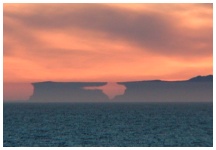
 Mountains That Aren't There The "arctic" or "superior" mirage occurs when an image of an object appears above the actual object. This is due to the downward refraction (bending) of light waves as they go through the cold, dense air that is close to the ground. Mirages can take looming, towering, or inverted forms, depending on the density structure of the air, and sometimes, that can be downright deceiving. In 1818, while seeking the Northwest Passage, British explorer John Ross sailed into Lancaster Sound but saw mountains blocking his way. He decided he could go no further and named the range the Crocker Mountains, after the First Secretary of the Admiralty. This was unfortunate, because Lancaster Sound is indeed a route to the Northwest Passage. William Edward Parry sailed through those very "mountains" the following year. The mountain range had been a mirage. Not only was an opportunity missed, but the Admiralty wasn't very happy with Ross - especially Crocker, who had imaginary mountains named after him! The Admiralty wouldn't give Johnny another ship, and he had to find private funding for his next expedition.
Click pictures for more information and credits. Library: Arctic, Environment/Atmosphere Fata Morgana, Halos & Sun Dogs Ice Blink & Water Sky, Fogbows Links: Arctic Arctic Maps & Weather Reports The Arctic Mirage |

|
DICTIONARY: Just "double-click" any unlinked word on this page for the definition from Merriam-Webster's Student Electronic Dictionary at Word Central. |

|
ARCTIC LIBRARY & GLOSSARY: Check this section for an index of the rest of the things you really need to know about the Arctic. |

|
ARCTIC MAPS & WEATHER REPORTS: Maps of the Northwest Passage, explorers' routes, iceberg sources, Nunavut, the Arctic by treeline, temperature... |

|
ARCTIC LINKS: Even more information! Links to sites related to the Arctic and "Iceberg: the Story of the Throps and the Squallhoots". |

|
GUIDE TO ARCTIC SUNRISE & SUNSET: How much sunlight or darkness is there in the Arctic on each day of the year? |
to is the property of their respective owners, and Athropolis is not responsible for their content.